In a C++ console application on windows, i'm trying to break the MAX_PATH restriction for the SetCurrentDirectoryW function.
There are many similar questions already asked but none got a usable answer:
- How to enable "Long Path Aware" behavior via manifest in a C++ executable?
- Are long path behavior per app can be enable via the manifest?
Doc Research
Apparently this might be possible by using application manifest files. The docs for SetCurrentDirectoryW state:
Tip Starting with Windows 10, version 1607, for the unicode version of this function (SetCurrentDirectoryW), you can opt-in to remove the MAX_PATH limitation. See the "Maximum Path Length Limitation" section of Naming Files, Paths, and Namespaces for details.
And from the general docs about Manifests:
Manifests are XML files that accompany and describe side-by-side assemblies or isolated applications. ... Application Manifests describe isolated applications. They are used to manage the names and versions of shared side-by-side assemblies that the application should bind to at run time. Application manifests are copied into the same folder as the application executable file or included as a resource in the application's executable file.
The docs about Assembly Manifests point out the difference to Application Manifests once more:
As a resource in a DLL, the assembly is available for the private use of the DLL. An assembly manifest cannot be included as a resource in an EXE. An EXE file may include an Application Manifests as a resource.
The docs about Application Manifests list the assembly and assemblyIdentity elements as required:
The assembly element requires exactly one attribute:
- manifestVersion
- The manifestVersion attribute must be set to 1.0.
- manifestVersion
The assemblyIdentity element requires the following attributes:
- type
- The value must be Win32 and all in lower case
- name
- Use the following format for the name: Organization.Division.Name. For example Microsoft.Windows.mysampleApp.
- version
- Specifies the application or assembly version. Use the four-part version format: mmmmm.nnnnn.ooooo.ppppp. Each of the parts separated by periods can be 0-65535 inclusive. For more information, see Assembly Versions.
- type
All other elements and attributes seem to be optional.
Additional requirements for the assembly element are:
Its first subelement must be a noInherit or assemblyIdentity element. The assembly element must be in the namespace "urn:schemas-microsoft-com:asm.v1". Child elements of the assembly must also be in this namespace, by inheritance or by tagging.
Finally, there's the longPathAware element which is optional but which should hopefully allow SetCurrentDirectoryW to use long paths:
Enables long paths that exceed MAX_PATH in length. This element is supported in Windows 10, version 1607, and later. For more information, see this article.
The section in the docs shows this example xml manifest:
<assembly xmlns="urn:schemas-microsoft-com:asm.v1" manifestVersion="1.0" xmlns:asmv3="urn:schemas-microsoft-com:asm.v3">
...
<asmv3:application>
<asmv3:windowsSettings xmlns:ws2="http://schemas.microsoft.com/SMI/2016/WindowsSettings">
<ws2:longPathAware>true</ws2:longPathAware>
</asmv3:windowsSettings>
</asmv3:application>
...
</assembly>
It doesn't seem to exactly follow the rules from the assembly element:
The assembly element must be in the namespace "urn:schemas-microsoft-com:asm.v1". Child elements of the assembly must also be in this namespace, by inheritance or by tagging.
Tests
The test environment is:
- Windows 10 21H2 x64 19044.1586
- VS2022 17.1.1
- Windows SDK Version 10.0.20348.0
The test application is a new c++ console application where i made the following change to the Additional Manifest Files:

The source code is very simple; it's also on godbolt but without the manifest:
#include <iostream>
#include <string>
#include <windows.h>
int main() {
std::wstring const path = LR"(H:\test\longPaths\manySmallLongPaths\12345678\12345678\12345678\12345678\12345678\12345678\12345678\12345678\12345678\12345678\12345678\12345678\12345678\12345678\12345678\12345678\12345678\12345678\12345678\12345678\12345678\12345678\12345678\12345678\12345678\12345678\12345678\12345678\12345678\12345678\12345678\12345678\12345678\12345678\12345678\12345678\12345678\12345678\)";
std::wstring const path2 = LR"(\\?\)" + path;
if (!SetCurrentDirectoryW(path.c_str())) {
printf("Exe SetCurrentDirectory failed 1 - (%d)\n", GetLastError());
if (!SetCurrentDirectoryW(path2.c_str()))
printf("Exe SetCurrentDirectory failed 2 - (%d)\n", GetLastError());
}
}
Trying to put this all together, i think the following file might be a valid Application Manifest:
<?xml version='1.0' encoding='UTF-8' standalone='yes'?>
<assembly xmlns:asmv1='urn:schemas-microsoft-com:asm.v1' manifestVersion='1.0'>
<asmv1:assemblyIdentity type='win32' name='my.test.app' version='1.0.0.0' />
<asmv1:application>
<asmv1:windowsSettings>
<asmv1:longPathAware>true</asmv1:longPathAware>
</asmv1:windowsSettings>
</asmv1:application>
</assembly>
But compiling and starting the application results in the following error:
The application has failed to start because its side-by-side configuration is incorrect. Please see the application event log or use the command-line sxstrace.exe tool for more detail.
Using sxstrace.exe reveals:
INFO: Parsing Manifest File C:\test\longPaths.exe.
INFO: Manifest Definition Identity is my.test.app,type="win32",version="1.0.0.0".
ERROR: Line 2: The element ws1:longPathAware appears as a child of element urn:schemas-microsoft-com:asm.v1^windowsSettings which is not supported by this version of Windows.
ERROR: Activation Context generation failed.
Maybe
Child elements of the assembly must also be in this namespace
is not entirely true (anymore) or i interpreted this wrong. Trying with a completed example from the longPathAware element:
<assembly xmlns:asmv1="urn:schemas-microsoft-com:asm.v1" manifestVersion="1.0" xmlns:asmv3="urn:schemas-microsoft-com:asm.v3">
<asmv1:assemblyIdentity type='win32' name='my.test.app' version='1.0.0.0' />
<asmv3:application>
<asmv3:windowsSettings xmlns:ws2="http://schemas.microsoft.com/SMI/2016/WindowsSettings">
<ws2:longPathAware>true</ws2:longPathAware>
</asmv3:windowsSettings>
</asmv3:application>
</assembly>
runs the application successfully, but without long path awareness (windows error code 206 = ERROR_FILENAME_EXCED_RANGE):
Exe SetCurrentDirectory failed 1 - 206
Exe SetCurrentDirectory failed 2 - 206
I checked the final embedded resource but it's definitively there:

To finish
i can only say that i don't know what else to test or if adding longPathAware element to the manifest is even possible with the type of application i'm trying to achieve that.
Maybe there's another api to change the current working folder of my application to a long path, and i would be fine with it, but at least _chdir and std::filesystem::current_path have the same limitations.
Workarounds
Using short names aka. 8.3 aliases might provide a limited work around.
For my cases this is often not feasible because short paths don't need to exists; they can be controlled system wide or per volume:
- The general state can be queried with
fsutil 8dot3name query - The per volume setting can be queried with
fsutil behavior query disable8dot3 c:
Sidenotes
- The manifest can be embedded in the executable or a dll.
- It will be ignored when the dll containing it is delay loaded.
- It will not be ignored by the delay loaded dll when the executable is containing it.
- Because the Manifest is "additional" in the project settings, it doesn't need the assemblyIdentity element.